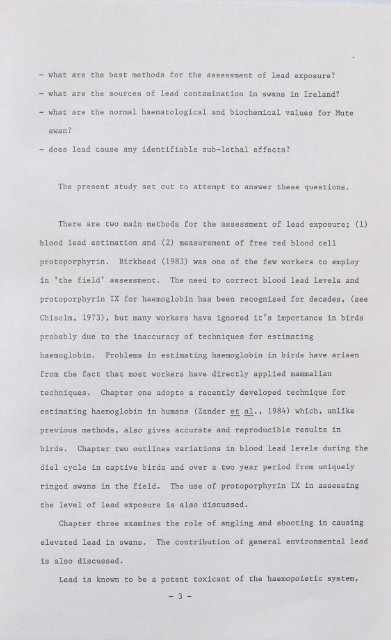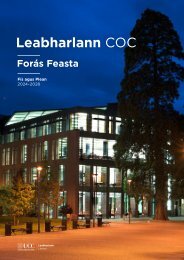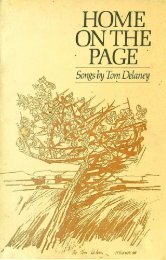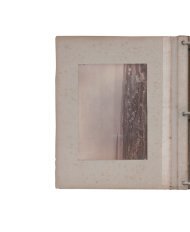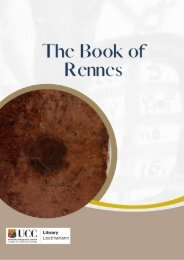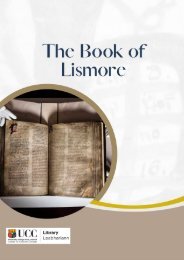Lead Toxicity in Mute Swans
LEAD TOXICITY IN MUTE SWANS Cygnus olor (Gmelin). By JOHN O'HALLORAN A thesis submitted to the National University of Ireland in candidature for the degree of Doctor of Philosophy September 1987
LEAD TOXICITY IN MUTE SWANS
Cygnus olor (Gmelin).
By
JOHN O'HALLORAN
A thesis submitted to the National University of Ireland
in candidature for the degree of Doctor of Philosophy
September 1987
Create successful ePaper yourself
Turn your PDF publications into a flip-book with our unique Google optimized e-Paper software.
- what are the best methods for the assessment of lead exposure?<br />
- what are the sources of lead contam<strong>in</strong>ation <strong>in</strong> swans <strong>in</strong> Ireland?<br />
- what are the normal haematological and biochemical values for <strong>Mute</strong><br />
swan?<br />
- does lead cause any identifiable sub-lethal effects?<br />
The present study set out to attempt to answer these questions.<br />
There are two ma<strong>in</strong> methods for the assessment of lead exposure; (1)<br />
blood lead estimation and (2) measurement of free red blood cell<br />
protoporphyr<strong>in</strong>.<br />
Birkhead (1983) was one of the few workers to employ<br />
<strong>in</strong> 'the field' assessment.<br />
The need to correct blood lead levels and<br />
protoporphyr<strong>in</strong> IX for haemoglob<strong>in</strong> has been recognised for decades, (see<br />
Chisolm, 1973), but many workers have ignored it's importance <strong>in</strong> birds<br />
probably due to the <strong>in</strong>accuracy of techniques for estimat<strong>in</strong>g<br />
haemoglob<strong>in</strong>.<br />
Problems <strong>in</strong> estimat<strong>in</strong>g haemoglob<strong>in</strong> <strong>in</strong> birds have arisen<br />
from the fact that most workers have directly applied mammalian<br />
techniques.<br />
Chapter one adopts a recently developed technique for<br />
estimat<strong>in</strong>g haemoglob<strong>in</strong> <strong>in</strong> humans (Zander et al., 1984) which, unlike<br />
previous methods, also gives accurate and reproducible results <strong>in</strong><br />
birds.<br />
Chapter two outl<strong>in</strong>es variations <strong>in</strong> blood lead levels dur<strong>in</strong>g the<br />
diel cycle <strong>in</strong> captive birds and over a two year period from uniquely<br />
r<strong>in</strong>ged swans <strong>in</strong> the field.<br />
The use of protoporphyr<strong>in</strong> IX <strong>in</strong> assess<strong>in</strong>g<br />
the level of lead exposure is also discussed.<br />
Chapter three exam<strong>in</strong>es the role of angl<strong>in</strong>g and shoot<strong>in</strong>g <strong>in</strong> caus<strong>in</strong>g<br />
elevated lead <strong>in</strong> swans.<br />
The contribution of general environmental lead<br />
is also discussed.<br />
<strong>Lead</strong> is known to be a potent toxicant of the haemopoietic system,<br />
- 3 -


